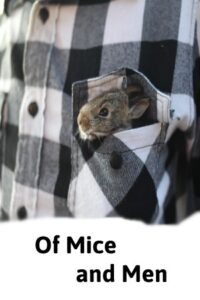Of Mice and Men
Context
 Steinbeck’s Of Mice and Men is a novella in the genres of realism and social protest in that it depicts a prevailing social problem and dramatises it through its effect on innocent characters. The story is about two travelling ranch workers who are trying to earn enough money to purchase their own land in Depression-era America. Following WW1, the economic downturn in America saw a rapid decline in farm crop pricing that resulted in farmers having to find ways to increase productivity, and many farmers went into debt through purchasing more land and expensive agricultural equipment. Intensified farming across the Great Plains states, between the Mississippi River and the Rocky Mountains, subsequently caused soil erosion and, combined with a seven-year drought and severe dust storms that began in 1931, what was once fertile land was turned into a desert landscape that came to be known as the Dust Bowl.
Steinbeck’s Of Mice and Men is a novella in the genres of realism and social protest in that it depicts a prevailing social problem and dramatises it through its effect on innocent characters. The story is about two travelling ranch workers who are trying to earn enough money to purchase their own land in Depression-era America. Following WW1, the economic downturn in America saw a rapid decline in farm crop pricing that resulted in farmers having to find ways to increase productivity, and many farmers went into debt through purchasing more land and expensive agricultural equipment. Intensified farming across the Great Plains states, between the Mississippi River and the Rocky Mountains, subsequently caused soil erosion and, combined with a seven-year drought and severe dust storms that began in 1931, what was once fertile land was turned into a desert landscape that came to be known as the Dust Bowl.
Exacerbating the economic situation was the stock market crash of 1929, which lead to the Great Depression, when banks foreclosed on mortgages and many farmers were unable to repay their debts. Subsequently, many rural poor and migrant farmers from the western states headed to California in search of work and a new life. Migrant workers were treated disdainfully by Californian farmers and locals, and pejoratively referred to as Okies (even though not all workers came from Oklahoma) which intensified their sense of displacement. It is within this social and political context of 1930s America, when the nation’s unemployment rate peaked at 25 per cent (in 1933), that Steinbeck locates his characters, living nomadic and restrictive lives in an environment of economic inequality.
Steinbeck uses slang dialogue and themes of power, prejudice, loneliness, and the struggle for independence to realistically portray migrant workers from the Depression era. He illustrates their suffering and powerlessness and how their cheap labour was exploited by indifferent landowners.
Of Mice and Men was made into a movie three times, in 1939, 1982, and in 1992 starting Gary Sinise and John Malkovich.
